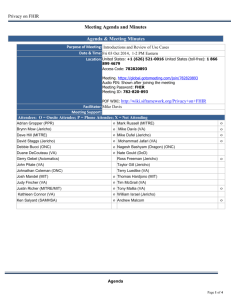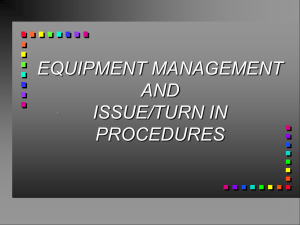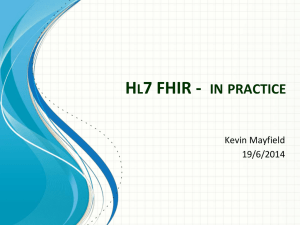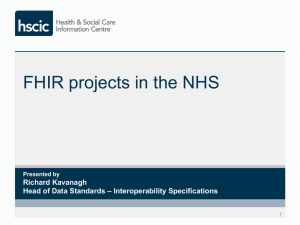Privacy on FHIR Meeting Agenda 2014 0930 kc
advertisement
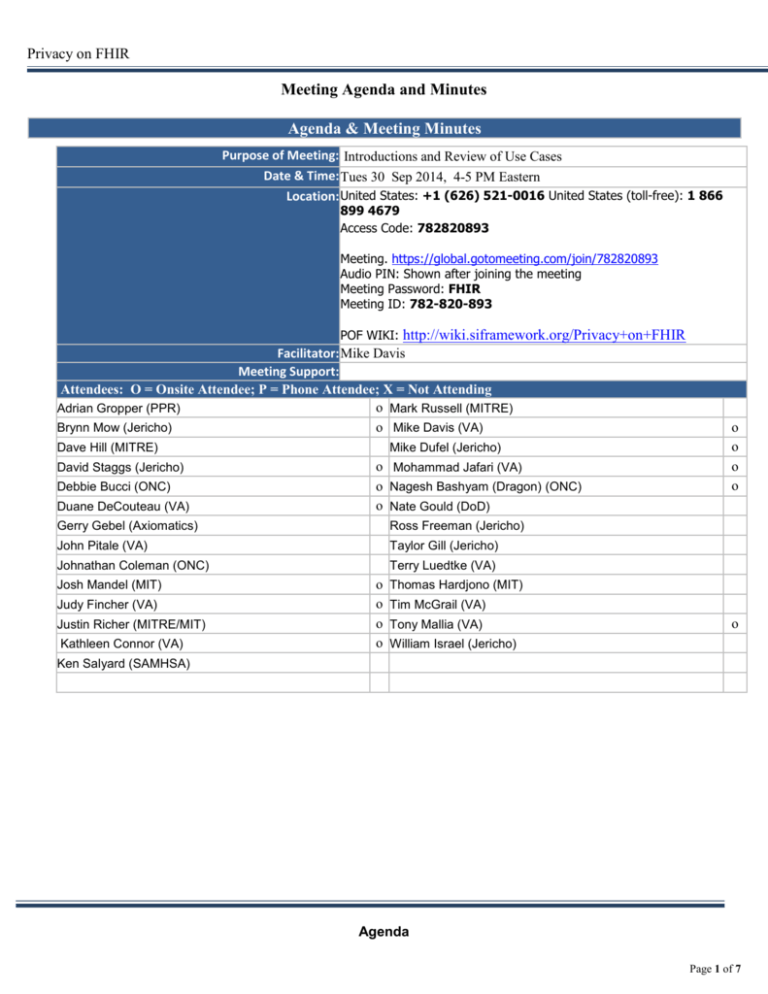
Privacy on FHIR Meeting Agenda and Minutes Agenda & Meeting Minutes Purpose of Meeting: Introductions and Review of Use Cases Date & Time: Tues 30 Sep 2014, 4-5 PM Eastern Location: United States: +1 (626) 521-0016 United States (toll-free): 1 866 899 4679 Access Code: 782820893 Meeting. https://global.gotomeeting.com/join/782820893 Audio PIN: Shown after joining the meeting Meeting Password: FHIR Meeting ID: 782-820-893 POF WIKI: http://wiki.siframework.org/Privacy+on+FHIR Facilitator: Mike Davis Meeting Support: Attendees: O = Onsite Attendee; P = Phone Attendee; X = Not Attending o Mark Russell (MITRE) Adrian Gropper (PPR) o Mike Davis (VA) Brynn Mow (Jericho) Dave Hill (MITRE) David Staggs (Jericho) Debbie Bucci (ONC) Duane DeCouteau (VA) Mike Dufel (Jericho) o Mohammad Jafari (VA) o Nagesh Bashyam (Dragon) (ONC) o Nate Gould (DoD) Gerry Gebel (Axiomatics) Ross Freeman (Jericho) John Pitale (VA) Taylor Gill (Jericho) Johnathan Coleman (ONC) Terry Luedtke (VA) Josh Mandel (MIT) Judy Fincher (VA) Justin Richer (MITRE/MIT) Kathleen Connor (VA) o o o o o o o o Thomas Hardjono (MIT) Tim McGrail (VA) Tony Mallia (VA) o William Israel (Jericho) Ken Salyard (SAMHSA) Agenda Page 1 of 7 Privacy on FHIR Meeting Agenda ID Topic 1 Minutes, Agenda Presenter Kathleen, Mike 5 min 2 Updated Use Cases/Storyboards (Review comments Friday) Kathleen 5 min 3 HIE on FHIR Updated UMA Diagram (Finalize today) Mohammad 5 min 4 HIE on FHIR Sequence Diagram (Finalize today) David Staggs 10 min 5 MIT Update (Minutes?) Adrian, Debbie 10 min 6 Resource Discussion (Bill of Lading) All 7 HL7 Demo/Code Models Duane Project Deliverables HIMSS Deliverables 1. “Wow” powered use cases meant to capture imagination and win hearts and mind [aka “Elevator Pitch”] All 2. Storyboards intended to convey business requirements and standards landscape to developers 3. Architecture a) Choreographies and data element exchanged b) Diagram showing subsystems and connections between them c) Flow diagram showing activities and message movement between subsystems d) Elements passed in the Tokens or request headers relevant to access control 4. Reference Model (Open source executable code to serve as model for developers, models, requirements and profile) 1. “Wow” Power PoF Overview Presentation and HIMSS Slide (1 per booth) Kathleen Use cases 2. Storyboards TBD 3. Architecture a) Dragons Diagrams b) Mohammad Diagrams c) Mohammad Sequence Diagrams d) Project Brief 4. Reference Models VA provided SLS/PPS, Test Models. SAMHSA Consent2Share open CDMS Key Discussion Notes ID Topic 1 HoF Model Diagram and Booth Diagrams will be updated to indicate that the End User is a FHIR Client and that the ACS on the Requester side is control by the Requester’s RS to enforce access permissions conveyed by Security Labeled/Privacy Protected disclosure from Custodian RS. Agenda Page 2 of 7 Privacy on FHIR Project Deliverables 2 Wrt to HoF Model Diagram and Booth Diagrams, the senders and receivers could be any of the HIE actors, which are HIPAA Covered Entities/~Covered Entities (e.g., SSA)/Business Associates (e.g., HIEs). 3 PoF should highlight the distinguishing business/policy requirements among HoF/AoF/CoF that result in differences in the manner in which each flow is architected. E.g., because HoF custodians may have policies that override the patient’s preferences (or to which the patient’s preferences must be constrained via policy adjudication), the flows need to support a redirect from Custodian’s ACS to Custodian’s preferred AS, thereby possibly overriding the Patient’s AS authorizations, which might block a Requester from accessing resources that the Custodian would otherwise disclose per applicable policy. 4 Assume that CDMS has digital signature capabilities. Action Items ID Action Items 1 Assigned to 3 Due Date How do we constrain the scope of the use cases? We have seven months to complete and test Demo. What resources are available and what can be provided by each of us? Post materials to S&I PoF page http://wiki.siframework.org/Pr ivacy+on+FHIR Status Comments 0926 Added Standards 6/2014 All 2 Assign Date Mike 9/2014 0912 KC 0908 0819 COMPLETE Three identified. 0613 Need to know how many separate items. For Review 0923 Complete Possible multiple booths or POD. 1. Patient App scenario 2. Consent Directives 3. HIE 4. Standards on FHIR 0829 Bill of Lading in today’s presentation 0923 Documents starting to be uploaded. 0913 Dragon assisted Mike with uploading to the ONC PoF Wiki 4 Update the HoF diagram to include a single trusted AS for the Happy Path. Tony and Mohammad 9/22 9/26 0926 Complete Accepted by Group Agenda Page 3 of 7 Privacy on FHIR Next Meeting Date: 3 OCT 2014 Time: 1-2 PM (Eastern) Location: Dial-In Line: Debbies GoToMeeting September 30 Minutes Mike covered agenda. Kathleen reviewed Sept. 26 Minutes. Mohammad walked through the updated HoF Diagram. Discussion ensued to clarify the ACS on the Client/Requester side. Group came to agreement that both the Requester and the Custodian RS actors in the HoF Model Diagram should be generic as to types of HIPAA Covered Entities/~Covered Entities (e.g., SSA)/Business Associates (e.g., HIEs). Mohammad to update. Mike Davis walked through the HoF Booth Diagram (below) and asked for comments. Debbie thought this diagram is cleaner showing the AS in a neutral zone. Josh agreed that despite the demo only featuring one AS, having the AS in the neutral zone “helps tell the story”. However, he voiced “OAuth nerd” reservations about Steps 4 through 8 because there is “No user on the wire.” Agenda Page 4 of 7 Privacy on FHIR Adrian prompted a round of discussion about how the patient’s privacy preferences are consumed/adjudicated by AS/CDMS given that the patient gives AS Authorization/CDMS that may not be revisited every time these are enforced. Debbie asked if the diagram would be simpler without the precursor Steps 1 – 3. Mike Davis noted that while the precursor steps are redundant with CoF, these are important links to precursor booths. Team came to similar conclusion about the HoF Booth Diagram as for the HoF Model Diagram – the senders and receivers could be any of the HIE actors. Mike Davis asked whether to re-label Healthcare provider/Healthcare consumer. Adrian approved, no one objected. So HoF Booth and model diagrams approved. David walked through the HoF Sequence diagram. Kathleen asked if a rolled up version of David’s Sequence Diagrams could illustrate where HoF and AoF are not aligned to highlight how the architecture is differently structured because of different policy domains. Adrian stated that he found the HoF Sequence Diagram confusing without Patient GUI. David stated that CDMS is separate from custodian. Custodian presents a document to patient for authorization/CD that conforms to the custodian’s pre-approved CD forms. David offered AG to mark up the diagram. David described a workflow for the CD. Mike Davis stated that he wasn’t sure that the CDMS is the custodian of the patient’s CD if the custodian needs a signed CD that the Custodian must maintain and use for enforcement. But patient may update. AG – GUI should be in Custodian. Mike Davis stated that CDMS can create a Custodian specific CD. Patient can fill out the Custodian CD preapproved form and send as FHIR resource to the Custodian. Mike Davis asked what changes need to be made. He thinks that the Custodian makes decision on what parts of the CD the Custodian gets to approve, and then the patient must either sign as accepting or decline. Custodian presents a GUI – after the patient provides privacy preferences Adrian described how the MA HIE is implementing an electronic signature capability for the CD form GUI. Mike Davis described the different types of FHIR CD templates that are being developed for FHIR. Not all will need to be adjudicated against a Custodian’s policies. Mike asks David to add a line indicating that the Custodian adjudicates the patient’s preferences and sends the “pre-approved CD” to Patient’s CDMS for digital signature. Adrian wanted the PoF models to show how the CDMS has the GUI with signature capacity. Mike Davis asserted that in order to keep electronic and avoid manual adjudication, the CDMS, which is trusted by the custodian, provides a patient signed CD with CDMS notary signature over it. Mike Dufel asked why does this have to be so complex – why not a lightweight electronic signature? Mike Davis responded that the VA attorneys wanted something legally accountable for the patient, so the VA needs a consistent electronically computable digital signature, i.e., not one that requires a person to compare the previous electronic signature with a subsequent electronic signature. Everybody knows how to process a digital signature. Also, the FHIR CD Resource is designed to be a signed Resource. Agenda Page 5 of 7 Privacy on FHIR David stated that the Jericho CDMS has an electronic signature service/notary service. His concern is to have a central place for patient to go to for CD. Mike Davis asserted that in order to keep electronic and avoid manual adjudication, the CDMS, which is trusted by the custodian, provides a patient signed CD with CDMS notary signature over it. Mike Dufel asked why so do signatures have to be so complex – why not a lightweight electronic signature? Mike Davis responded that the VA attorneys wanted something legally accountable for the patient. However, VA needs a consistent electronically computable digital signature, i.e., one that does not requires a person to compare the previous electronic signature with a subsequent electronic signature. Everybody knows how to process a digital signature. At the top of the hour Mike Davis adjourned the call and asked the team to please take a look at Bill of Lading and minutes for Friday, October 3rd call. Agenda Page 6 of 7 Privacy on FHIR Agenda Page 7 of 7
